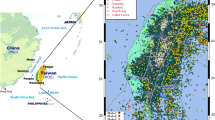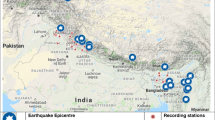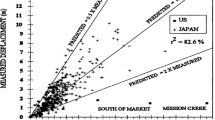Abstract
In this study, neural network models improved by genetic algorithm were employed to estimate peak ground acceleration (PGA) at seven metropolitan areas in the island of Taiwan, which is frequently subject to earthquakes. By considering a series of historical seismic records, and using the seismic design value in the current building code as the evaluation criteria, two metropolitan areas, Taichung and Chiayi, were identified by computational results as having higher estimated horizontal PGAs than the recommended design values. The approach implemented in this study provides a new and good basis for solving this type of seismic problems in the region studied.







Similar content being viewed by others
References
Alves EI (2006) Earthquake forecasting using neural networks: results and future work. Nonlinear Dynam 44:341–349
Gentili S, Bragato P (2006) A neural-tree-based system for automatic location of earthquakes in Northeastern Italy. J Seismol 10:73–89
Ghaboussi J, Lin CJ (1998) New method of generating spectrum compatible accelerograms using neural networks. Earthquake Eng Struct Dynam 27:377–396
Lee SC, Han SW (2002) Neural-network-based models for generating artificial earthquakes and response spectra. Comput Struct 80:1627–1638
Panakkat A, Adeli H (2007) Neural network models for earthquake magnitude prediction using multiple seismicity indicators. Int J Neural Syst 17(1):13–33
Cook DF, Ragsdale CT, Major RL (2000) Combining a neural network with a genetic algorithm for process parameter optimization. Eng Appl Artif Intell 13:391–396
Gunaratnam D, DeGroff T, Fricke F (2000) Dimensionality reduction in neural network modelling using dimensional theory and genetic algorithm. In: Dagli CH et al (eds) Intelligent engineering systems through artificial neural networks, vol 10. American Society of Mechanical Engineering, Newyork, pp 133–138
Kim GH, Yoon JE, An SH, Cho HH, Kang KI (2004) Neural network model incorporating a genetic algorithm in estimating construction costs. Build Environ 39:1333–1340
Li S, Li Y, Liu Y, Xu Y (2007) A GA-based NN approach for makespan estimation. Appl Math Comput 185:1003–1014
Sexton RS, Gupta JND (2000) Comparative evaluation of genetic algorithm and backpropagation for training neural networks. Inf Sci 129:45–59
Wikipedia Encyclopedia (2008) Pacific ring of fire. Wikimedia Foundation Inc., US. http://en.wikipedia.org/wiki/Pacific_Ring_of_Fire
Central Weather Bureau (2005) One hundred questions of earthquake. Ministry of Transportation, Taiwan. http://www.cwb.gov.tw
Crystalinks (2008) Pacific ring of fire. http://www.crystalinks.com/rof.html
Kerh T, Chu D (2002) Neural networks approach and microtremor measurements in estimating peak ground acceleration due to strong motion. Adv Eng Softw 33:733–742
Kerh T, Lee JH, Chen LY (1996) Estimation of strong motion using microtremor measurement at the main lines of Kaohsiung mass rapid transit. J Civil Eng Technol 7:15–40
Kerh T, Ting SB (2005) Neural network estimation of ground peak acceleration at stations along Taiwan high-speed rail system. Eng Appl Artif Intell 18:857–866
Kerh T, Lai JS, Gunaratnam D, Saunders R (2008) Evaluation of seismic design values in the Taiwan building code by using artificial neural network. CMES-Comput Model in Eng Sci 26(1):1–12
Adeli H (2001) Neural network in civil engineering: 1989–2000. Comput-Aided Civil Infrastruct Eng 16:126–142
Pu Y, Mesbahi E (2006) Application of artificial neural networks to evaluation of ultimate strength of steel panels. Eng Struct 28:1190–1196
Sarghini F, de Felice G, Santini S (2003) Neural networks based subgrid scale modeling in large eddy simulations. Comput Fluids 32:97–108
Chow H, Chen H, Ng T, Myrdal P, Yalkowsky SH (1995) Using backpropagation networks for the estimation of aqueous activity coefficients of aromatic organic compounds. J Chem Inform Comput Sci 35:723–728
Wilson DR, Martinez TR (2001) The need for small learning rates on large problems. In: Proceedings of the international joint conference on neural networks, pp 115–119
Chambers L (2000) The practical handbook of genetic algorithms: applications. CRC Press, Boca Raton, pp 1–528
Gupta A, Kripakaran P, Mahinthakumar G, Baugh JW Jr (2005) Genetic algorithm-based decision support for optimizing seismic response of piping systems. J Struct Eng 131(3):389–398
Loughlin DH, Ranjithan SR, Brill ED Jr, Baugh JW Jr (2001) Genetic algorithm approaches for addressing unmodeled objectives in optimization problems. Eng Optimiz 33:549–569
Wu S, Chou L, Lee S, Chang BZ (2003) MATLAB neural networks simulation and application. Science Publishing Company, China
User’s Guide (2004) GeneHunter targets optimal solutions with genetic. Ward Systems Group, Inc., Maryland, USA
Wikipedia Encyclopedia (2008) Hypocenter. Wikimedia Foundation Inc., US. http://en.wikipedia.org/wiki/Hypocenter
Cheng SL, Yeh YT (1989) Earthquake catalog in Taiwan area from 1604 to 1988. Research Project of Institute of Earth Sciences, Academia Sinica, Taiwan, IES-R-661, pp 253–253. http://tec.earth.sinica.edu.tw/
Kerh T, Lai JS, Chan Y (2007) Application of neural network in evaluating seismic design parameters for metropolitan areas in Taiwan. In: Proceedings of the international conference on advanced information technologies, No. 052, pp 01–06
Central Weather Bureau (2007) A picture collection of the most ten damaged earthquakes in Taiwan. Ministry of Transportation, Taiwan. http://scman.cwb.gov.tw/eqv5/10eq/10eq-index.htm
Acknowledgments
The financial support from National Science Council under Project Number NSC97-2221-E-020-022 is greatly appreciated. The historical seismic record provided by the Central Weather Bureau Seismological Center of Taiwan is also gratefully acknowledged.
Author information
Authors and Affiliations
Corresponding author
Rights and permissions
About this article
Cite this article
Kerh, T., Gunaratnam, D. & Chan, Y. Neural computing with genetic algorithm in evaluating potentially hazardous metropolitan areas result from earthquake. Neural Comput & Applic 19, 521–529 (2010). https://doi.org/10.1007/s00521-009-0301-z
Received:
Accepted:
Published:
Issue Date:
DOI: https://doi.org/10.1007/s00521-009-0301-z




